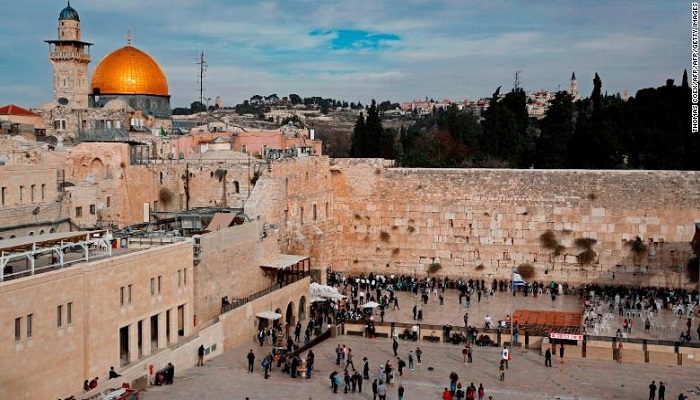
We all know that the latest decision by Donald Trump on Jerusalem has caused a global outrage in the Arab world. But do you know why?
Defying dire, worldwide warnings, President Donald Trump on Wednesday broke with decades of US and international policy by recognizing occupied Jerusalem as Israel’s capital.
Despite urgent appeals from Arab and European leaders and the risk of anti-American protests and violence, Trump declared that he was ending an approach that for decades has failed to advance the prospects for peace. He also for the first time personally endorsed the concept of a “two-state solution” for Israel and the Palestinians, provided both sides agree to it.
Here’s everything you need to know about Trump’s decision to recognize occupied Jerusalem as the capital of Israel.
What’s so special about occupied Jerusalem?
It’s sacred to followers of the three major monotheistic religions. It is home to the Temple Mount, the holiest site in the world for Jews, who come from around the world to pray at the Western Wall, the last remaining supporting wall of the biblical temple. Muslims revere the same plateau as the Noble Sanctuary, where the Al Aqsa mosque stands as the third-holiest place in Islam, after holy cities of Makkah and Madinah. Not far away in Jerusalem’s Old City is the Church of the Holy Sepulchre, which Christians revere as the site of Jesus’s tomb. When the United Nations voted in 1947 to divide British-ruled Palestine into separate Arab and Jewish states, it didn’t want either side controlling occupied Jerusalem, due to its religious resonance. Instead, it set aside the city as an international zone to be administered by a UN council of trustees.
So why does Israel control it?
Arab states rejected the UN partition plan for Palestine and launched a war against the fledgling Jewish state. The war left Israel in control of West Jerusalem, where the bulk of the Jewish population lived, and Jordan in control of the mostly Arab eastern side, containing the holiest sites. In 1967, Israel captured east Jerusalem in the Six-Day War and formally annexed those portions of the city to form one municipality under Israeli law. In 1980, its parliament passed a law declaring “complete and united” Jerusalem to be Israel’s capital. Most nations rejected the move. The only two that complied, Costa Rica and El Salvador, eventually moved their diplomatic posts to Tel Aviv, 70 kilometers to the west, where all the other embassies are located, under pressure from Arab states.
Does anyone still envision an international zone?
Not really. Vatican officials have periodically called for an “internationally guaranteed special statute” for occupied Jerusalem. However, the US, Russia, the European Union and the United Nations, acting collectively to advance peace between Israel and the Palestinians, have embraced the position that it’s up to the two sides to negotiate the status of occupied Jerusalem. Trump clarified after recognizing that occupied Jerusalem is Israel’s capital that the US takes no position on “the specific boundaries of Israeli sovereignty in occupied Jerusalem.” The issue has been among the knottiest in peace talks since the first Israeli-Palestinian accord, the 1993 Oslo agreement. Palestinians insist the city must be their capital and have picked a spot to build their parliament in east Jerusalem’s Abu Dis neighborhood. Israeli Prime Minister Benjamin Netanyahu’s government says occupied Jerusalem will remain the “undivided and eternal capital” of the Jewish people.
What have other presidents done?
Like Trump before today, Presidents Bill Clinton and George W. Bush vowed as candidates to relocate the US Embassy to occupied Jerusalem but backed away once in office amid warnings that the move could spark Arab violence or scuttle peace talks. The US Congress passed a law in 1995 requiring that the embassy is moved to Jerusalem by 1999, but the legislation included a provision allowing the president to waive the move for six months in the interest of national security – and that’s what has happened ever since. Before leaving the White House, Barack Obama signed the waiver for the last time on December 1, 2016. Trump renewed it for six months on June 1, after His Majesty King Abdullah II of Jordan warned him that moving the embassy would aggravate the Israeli-Palestinian conflict.
What would the US embassy move to Jerusalem entail
The US has no facility in Jerusalem big enough to house the work of its embassy in Tel Aviv. Building one would take years. Since 1989, the US has leased from the Israeli government a large plot of land in occupied Jerusalem’s Talpiot neighborhood, presumably for a future embassy. Robert Satloff, head of the pro-Israel Washington Institute, has argued that Trump could fulfill his promise by moving the American ambassador’s office to an existing US facility in occupied Jerusalem. The US has a consulate-general in occupied Jerusalem, which according to its website serves as the “de facto representative” of the US government to the Palestinian Authority, which administers the limited self-rule that Palestinians exercise under their agreements with Israel.

Post Your Comments